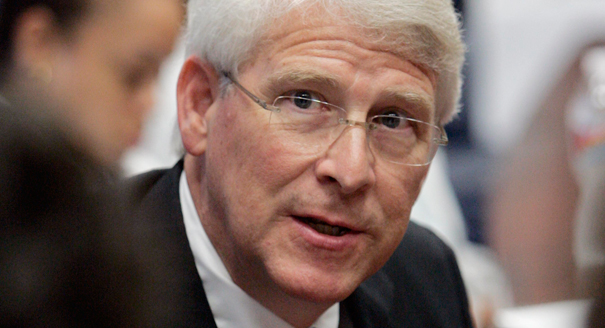Headlines
Wicker, Booker Unveil Railroad Reform, Amtrak Reauthorization
U.S. Senators Roger Wicker, R-Miss., and Cory Booker, D-N.J., introduced a bipartisan measure to improve passenger rail safety, reauthorize Amtrak services, and improve existing rail infrastructure yesterday.
The bill, “Railroad Reform, Enhancement, and Efficiency Act,” could receive a vote by the Senate Commerce, Science, and Transportation Committee as early as next week.
“The nation’s passenger rail system serves as an integral part of our overall transportation structure and our economy,” Wicker said. “The tragic accident in Pennsylvania last month was a heartbreaking reminder that the system is far from perfect. This bipartisan measure would make robust improvements to safety programs, improve existing infrastructure, and empower state and local officials. The bill also leverages private sector investment, cuts red tape, and increases transparency to make our critical infrastructure dollars go further. I would like to thank Senator Booker for his help in crafting this proposal.”
“To help the United States compete globally, we must invest in a safe and reliable passenger rail system that Americans can depend on,” Booker said. “But too often our rail system falls short due to a lack of adequate infrastructure investment. Our bipartisan bill takes important steps to improve rail safety in the wake of last month’s tragic derailment, modernize our aging passenger rail network, and maximize investments in infrastructure through improved financing and grant programs. The legislation allows Amtrak to reinvest Northeast Corridor profits back into improving Northeast Corridor infrastructure, including throughout New Jersey. This will help advance critical but long overdue initiatives like building the Gateway Project which adds a new tunnel under the Hudson River and replacing the declining Portal Bridge. Senator Wicker has been a tremendous partner in moving this important bill forward.”
The legislation would authorize Amtrak for the next four years at an average $1.65 billion a year. Additionally, $570 million in total grant funding would be made available every year. These competitive grants would go toward programs related to capital assistance, service enhancement and restoration, alleviating rail congestion, and the Northeast Corridor.
Highlights of the legislation include:
Increasing Safety
Advances deployment of Positive Train Control technology by authorizing grants and prioritizing loan applications to support its implementation.
Requires speed limit action plans to address automatic train control modifications, crew communication, and other speed enforcement issues.
Requires grade crossing action plans to facilitate and improve state grade crossing safety efforts.
Encourages the use of confidential close call reporting system programs to identify hazards before they lead to accidents.
Addresses other important safety issues such as signal protection, signage, alerters, and track inspection.
Leveraging Private Sector Investment and Facilitating Increased Competition
Generates opportunities for private-sector partnerships to develop rail stations.
Unlocks new revenue streams through right-of-way development.
Requires the Department of Transportation to solicit competitive proposals to achieve trip time savings on key corridors.
Requires the Department of Transportation to facilitate competition that could reduce state-supported and long-distance route costs by at least 10 percent.
Reforms the Railroad Rehabilitation and Improvement Financing program to create a faster, more flexible, and accessible application process, potentially accelerating major projects, such as building new Hudson River tunnels or replacing the Portal Bridge.
Cutting Red Tape to Make Taxpayer Dollars Go Further
Streamlines the permitting process for improvement to existing railroad track and related infrastructure.
Increases permitting review engagement among federal and state agencies.
Produces greater certainty by establishing deadlines for agency action and decisions.
Provides for the advance acquisition of property to control costs and improve project delivery
Improving Existing Infrastructure and Services
Consolidates existing grant programs to focus resources on the most critical safety and infrastructure improvements.
Establishes a working group for the restoration of passenger rail service east of New Orleans and creates a competitive grant program for fiscally-sustainable routes, potentially including the restoration of service abandoned after Hurricane Katrina.
Authorizes a federal-state partnership to achieve a state-of-good-repair for infrastructure controlled by states or Amtrak, including on the Northeast Corridor.
Demanding Accountability, Transparency, and Efficiency
Provides state partners and Congress with greater transparency into Amtrak’s budgeting.
Reforms Amtrak by requiring the separation of business line accounts, facilitating greater re-investment in Amtrak infrastructure, including the Northeast Corridor.
Adds more robust taxpayer protections to large rail equipment purchases and capital projects funded by the federal government.
Requires Amtrak to develop methodologies for determining what routes and services it should provide.
Requires the development of operational efficiency solutions on issues such as through-ticketing and joint procurement.
Empowering States
Enhances mutual cooperation and planning on state-supported routes operated by Amtrak.
Ensures broad, national representation on the Amtrak Board of Directors.
Creates opportunities for states to compete for fiscally-sustainable service enhancements.
Gives states greater say in infrastructure planning and improvements on the Northeast Corridor.


















Robert
June 19, 2015 at 9:01 am
Sounds like it contains ideas from both sides of the political aisle. Two things are clear. 1-America doesn’t want to give up on it’s rail passenger system. 2- There can’t be any more “business as usual” approach to our rail system that just throws money at it and hopes that things get better. The public wants results.